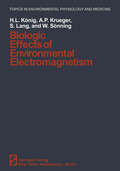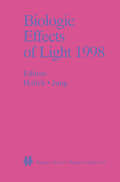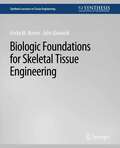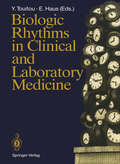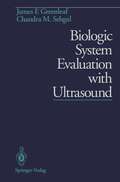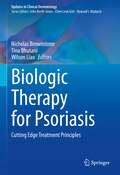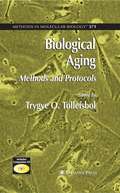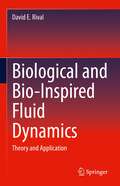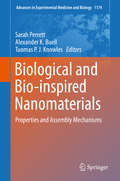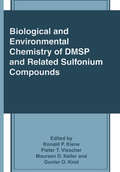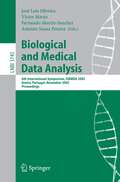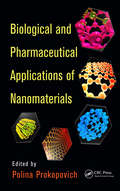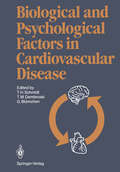- Table View
- List View
Biologic Effects of Environmental Electromagnetism (Topics in Environmental Physiology and Medicine)
by H. L. König A. P. Krüger S. Lang W. SönningARCHIVE COpy DO NOT REMOVE The public in industrialized countries shows a mounting concern about biological effects of electrical and magnetic fields. As a result, experimental studies on this subject are being published in increasing numbers throughout the world. Prof. H. L. Konig, of the Technical University of Munich, West Germany, a leading expert and pioneer in this field, has written an authoritative text in a lucid style which makes the material also accessible to lay readers. The book describes the effects of natural as well as artificial electromagnetic energies covering the en tire measurable frequency range from the highest frequencies, x-rays, through microwaves, radio waves, and finally extremely low frequency (ELF) waves. Cit ing the evidence from scientific studies in various countries, Konig also appraises the biologic effects of microwaves and high tension power lines, which have become controversial issues in recent years. Other contributions to the book have been made by Prof. Albert P. Krueger, University of California, Berkeley, on air ionization effects and by the mete orologist Walter Sonning on biometeorology, documenting the influence of atmo spheric electrical currents on health and disease. Moreover, the late Dr. Siegnot Lang, a former coworker of Dr. Konig, has contributed to this book.
Biologic Effects of Light 1998: Proceedings of a Symposium Basel, Switzerland November 1–3, 1998
by Ernst G. Jung Michael F. HolickIt is remarkable how much we take for granted the tremendous energy and vitality that the sun provides earth's inhabitants. As we enter the new millennium, it is worthwhile to review how our ancestors perceived the biologic effects of sunlight, and how science and medicine have advanced our knowledge about the biologic effects of light. At the turn of the century, a multitude of investigators explored the use of sunlight and artificial radiation for treating a multitude of diseases. These explorations gave rise to photodynamic therapy, phototherapy, and chemophototherapy. However, enthusiasm for using sunlight and artificial radiation to treat disease was dampened with the birth of pharmacology. It was the goal of the Fifth International Arnold Rikli Symposium on the Biologic Effects of Light, held in Basel, Switzerland, on November 1-3, 1998, to review the history of phototherapy and have some of the world's leading experts on the biologic effects of light provide new perspectives on the positive and negative effects of light. The general topics included a broad range of biologic effects of sunlight, artificial ultraviolet radiation and electromagnetic radiation. Special sessions on radiation and vitamin D and bone health, photoimmunology, biopositive effects of UV radiation, effects of electromagnetic currents and fields, and ocular and non-ocular regulation of circadian rhythms and melatonin, should be of particular interest to readers of Biologic Effects of Light.
Biologic Effects of Light 2001: Proceedings of a Symposium Boston, Massachusetts June 16–18, 2001
by Michael F. HolickAs humans ventured into the twentieth century, the industrialized countries were confronted with the scourge of rickets. Although solariums were becoming common in the early 1900s and phototherapy was gaining popularity as a result of the awarding of a Nobel Prize to Finsen in 1903, it wasn't until 1921 when Hess and Unger demonstrated that rickets could be cured by exposure to sunlight that the healthful benefit of sun exposure appreciated. In 1941, Apperly (Cancer Research; 1: 191-195, 1941) noted that the occasional increased risk of skin cancer was associated with a decreased risk of many other more common and serious cancers. The alarming increase in the number of cases of skin cancer, especially melanoma, has caused great concern about the negative role of sunlight in health. The Sixth International Arnold Rikli Symposium on the Biologic Effects of Light was held in Boston, Massachusetts from June 16th - 18th, 2001. The goal of this Symposium was to focus on the very popular practice of tanning either by sunlight or by artificial light sources and the overall impact this practice has on health and disease. The program was organized by members of the Scientific Advisory Committee and my co-chair emeritus, Professor Ernst G. Jung. The Program Committee organized an outstanding state-of-the-art program that was enthusiastically received by the participants.
Biologic Foundations for Skeletal Tissue Engineering (Synthesis Lectures on Tissue Engineering)
by Ericka Bueno Julie GlowackiTissue engineering research for bone and joint applications entails multidisciplinary teams bringing together the needed expertise in anatomy, biology, biochemistry, pathophysiology, materials science, biomechanics, fluidics, and clinical and veterinary orthopedics. It is the goal of this volume to provide students and investigators who are entering this exciting area with an understanding of the biologic foundations necessary to appreciate the problems in bone and cartilage that may benefit from innovative tissue engineering approaches. This volume includes state-of-the-art information about bone and cartilage physiology at the levels of cell and molecular biology, tissue structure, developmental processes, their metabolic and structural functions, responses to injury, mechanisms of post-natal healing and graft incorporation, the many congenital and acquired disorders, effects of aging, and current clinical standards of care. It reviews the strengths and limitations of various experimental animal models, sources of cells, composition and design of scaffolds, activities of growth factors and genes to enhance histogenesis, and the need for new materials in the context of cell-based and cell-free tissue engineering. These building blocks constitute the dynamic environments in which innovative approaches are needed for addressing debilitating disorders of the skeleton. It is likely that a single tactic will not be sufficient for different applications because of variations in the systemic and local environments. The realizations that tissue regeneration is complex and dynamic underscore the continuing need for innovative multidisciplinary investigations, with an eye to simple and safe therapies for disabled patients. Table of Contents: Introduction / Structure and Function of Bone and Cartilage Tissue / Development / Responses to Injury and Grafting / Clinical Applications for Skeletal Tissue Engineering / Animal Models / Tissue Engineering Principles for Bone and Cartilage / Perspectives
Biologic Knee Reconstruction: A Surgeon's Guide
by Joshua Harris Brian ColeTreatment of articular cartilage pathology in the knees of young and active patients is a challenging and controversial issue. Biologic Knee Reconstruction: A Surgeon's Guide is a how-to, step-by-step guide that addresses the evaluation and management of this unique patient population. Internationally renowned cartilage experts Dr. Brian J. Cole and Dr. Joshua D. Harris, along with their contributors, present information on normal and abnormal history and physical examination. The reader will learn proper decision-making using a patient-centered approach of treatment, increasing the likelihood of a successful outcome. In addition to radiographic assessment of articular cartilage, Biologic Knee Reconstruction discusses the use of biomarkers, defect classification, and patient-reported and surgeon-measured outcomes. Aggressive nonsurgical medical management, including medications, injections, physiotherapy, and rehabilitation, is also presented.Biologic Knee Reconstruction also discusses the management of concomitant pathologies such as malalignment, meniscal deficiency, and ligamentous instability. Selection of surgical cartilage restorative treatment options is multifactorial, requiring consideration of several patient-, knee-, and defect-specific issues. All contemporary open and arthroscopic cartilage techniques are presented in detail with high resolution figures. A unique feature of Biologic Knee Reconstruction is the presentation of several chapters discussing non-medical issues highly pertinent to the advancement and future of this field: funding of research and cost of new advanced technologies, regulation of advanced cellular, tissue, and genetic technologies, evidence-based medicine and clinical trial design and conduct, and the ethics of allograft tissues and stem cell use.Features: Technique preference cards from the experts performing cartilage surgery Patient education information The most up-to-date descriptions of advanced cartilage techniques Unique chapters not covered in books elsewhere, including: Biomarkers Patient-reported outcomes assessment Newer injection techniques (PRP, stem cells) One- and two-stage open and arthroscopic techniques using chondrocyte- and stem cell based cell therapies Costs and public and private funding of research Barriers to high-quality randomized trials Governmental regulation and availability/accessibility to patients Gene therapy and tissue engineering Ethics of articular cartilage surgery with stem cells, ex-vivo cell manipulation, and juvenile tissue sources With the most up-to-date content and step-by-step methods for surgical procedures, Biologic Knee Reconstruction: A Surgeon's Guide is the perfect addition to the bookshelf of the orthopedic surgeon, cartilage researcher, sports physical therapist, or athletic trainer who evaluates and manages this unique patient population.
Biologic Knee Reconstruction: A Surgeon's Guide
by Joshua Harris Brian ColeTreatment of articular cartilage pathology in the knees of young and active patients is a challenging and controversial issue. Biologic Knee Reconstruction: A Surgeon's Guide is a how-to, step-by-step guide that addresses the evaluation and management of this unique patient population. Internationally renowned cartilage experts Dr. Brian J. Cole and Dr. Joshua D. Harris, along with their contributors, present information on normal and abnormal history and physical examination. The reader will learn proper decision-making using a patient-centered approach of treatment, increasing the likelihood of a successful outcome. In addition to radiographic assessment of articular cartilage, Biologic Knee Reconstruction discusses the use of biomarkers, defect classification, and patient-reported and surgeon-measured outcomes. Aggressive nonsurgical medical management, including medications, injections, physiotherapy, and rehabilitation, is also presented.Biologic Knee Reconstruction also discusses the management of concomitant pathologies such as malalignment, meniscal deficiency, and ligamentous instability. Selection of surgical cartilage restorative treatment options is multifactorial, requiring consideration of several patient-, knee-, and defect-specific issues. All contemporary open and arthroscopic cartilage techniques are presented in detail with high resolution figures. A unique feature of Biologic Knee Reconstruction is the presentation of several chapters discussing non-medical issues highly pertinent to the advancement and future of this field: funding of research and cost of new advanced technologies, regulation of advanced cellular, tissue, and genetic technologies, evidence-based medicine and clinical trial design and conduct, and the ethics of allograft tissues and stem cell use.Features: Technique preference cards from the experts performing cartilage surgery Patient education information The most up-to-date descriptions of advanced cartilage techniques Unique chapters not covered in books elsewhere, including: Biomarkers Patient-reported outcomes assessment Newer injection techniques (PRP, stem cells) One- and two-stage open and arthroscopic techniques using chondrocyte- and stem cell based cell therapies Costs and public and private funding of research Barriers to high-quality randomized trials Governmental regulation and availability/accessibility to patients Gene therapy and tissue engineering Ethics of articular cartilage surgery with stem cells, ex-vivo cell manipulation, and juvenile tissue sources With the most up-to-date content and step-by-step methods for surgical procedures, Biologic Knee Reconstruction: A Surgeon's Guide is the perfect addition to the bookshelf of the orthopedic surgeon, cartilage researcher, sports physical therapist, or athletic trainer who evaluates and manages this unique patient population.
Biologic Rhythms in Clinical and Laboratory Medicine
by Yvan Touitou Erhard HausEveryone has heard of nature's "biological clocks", the phenomenon of periodic activity in plants, animals and humans. But what does chronobiology have to do with modern medicine? This book presents in a concise but comprehensive fashion the basic principles of chronobiology and their application to clinical medicine. The chapters are written by specialists in the field; they summarize the physiology, pathophysiology and pathology of the human time structure and outline the application of chronobiologic principles and techniques for diagnosis and treatment.
Biologic System Evaluation with Ultrasound
by James F. Greenleaf Chandra M. SehgalBiologic System Evaluation with Ultrasound is a reference book for engineers in the field of ultrasonics and is intended to inform those unfamiliar with current methods of ultrasonic analysis. Explaining the mathematical and physical principles of ultrasound imaging of living tissue with effective precision, the book encompasses the following topics: relationships between the biological and scattering hierarchies; graphic description of scattering; class 1,2,3,4 scattering and their association with the biological hierarchy; instruments used for biologic system evaluation; computed tomographic methods of imaging. The authors have provided an effective explanation of the ultrasound scattering of image and image acquisition that will benefit engineers, physicists, and radiologists alike.
Biologic Therapy for Psoriasis: Cutting Edge Treatment Principles (Updates in Clinical Dermatology)
by Tina Bhutani Wilson Liao Nicholas BrownstoneBiologic therapy is a treatment that strives to modulate a patient's immune system to fight a given disease. In psoriasis, a skin disorder that is partly caused by a dysregulated immune system resulting in well-demarcated red areas of the skin with white scales, biologic therapy has the potential to vastly improve upon patient outcomes by minimizing the symptoms of this disease while maximizing the safety profile of the therapy. This book offers an up-to-date and comprehensive review on biologic therapy for the treatment of psoriasis. With over 10 FDA approved biologic agents for psoriasis (with more in the pipeline), confusion exists among providers regarding which agent is best for a particular patient. Chapters cover all FDA approved psoriasis biologic agents (including pipeline agents) for use in pediatric, adult, and geriatric patients. This book is unique in that it will not only cover cutting edge treatment principles based on the latest research, it will also be one of the most comprehensive reviews of psoriasis biologics in the COVID-19 era. Biologic Therapy for Psoriasis is a must-have resource for board certified dermatologists and rheumatologists, dermatology and rheumatology residents and fellows, dermatology physician assistants, nurse practitioners and medical students. The ultimate goal of this book is to improve patient care by making the busy practicing dermatology provider more adept with these particular therapies.
Biologic Therapy of Leukemia (Contemporary Hematology)
by Matt KalaycioExciting new "biologic" therapies for treating leukemia are appearing so rapidly that clinicians often find it difficult to make informed decisions about their use when making patient treatment decisions. Biologic Therapy of Leukemia summarizes and reviews all the available data concerning these cutting-edge biologic therapies so that practicing clinicians can make the correct patient-care choices. Here the busy physician will find in one convenient place crucial information on the uses and limitations of the major biologic therapies for leukemia, the different biologic strategies for its treatment, the management of patients being treated with such biologic agents, and the current and future role of emerging biologic agents.
Biological Aging: Methods and Protocols (Methods in Molecular Biology #371)
by Trygve O. TollefsbolThis book investigates the various processes that are affected by the age of an organism. Several new tools for the analysis of biological aging have been introduced recently, and this volume provides methods and protocols for these new techniques in addition to its coverage of established procedures. Researchers seeking new technology and techniques will find this volume of tremendous benefit as they move towards new directions.
Biological Amplification Systems in Immunology (Comprehensive Immunology #2)
by N. DayInterest in complement developed at the end of the nineteenth century from observations on cellular and humoral defense mechanisms against bacteria. It was recognized at that time that there were factors in body fluids of animals and man that were capable of killing and lysing bacteria in the absence of cellular factors. Due to the efforts of two of the founders of immunology, Bordet and Ehrlich, and their colleagues, by 1912 the multicomponent nature of complement action was well recognized, the sequence of reaction of the components in the lysis of erythrocytes was defined, complement fixation as a major tool for studying antibody-antigen interaction was well established, and studies on the physicochemical properties of the components had been started. Yet, with a few notable exceptions, research on complement was largely abandoned by most "mainstream" immunologists for the following two or three decades. When one looks at the contents of the present volume, it is hard to imagine that as recently as 20 years ago, there were probably fewer than ten major laboratories where complement research was the primary theme. The contents attest to the fact that there are today dozens of laboratories on three continents where research on complement is pursued in depth. It is not easy to point to all the advances that have occurred in complement research during the past few years.
Biological and Bio-Inspired Fluid Dynamics: Theory and Application
by David E. RivalThis text provides the reader with tools necessary to study biological and bio-inspired flows, all the while developing an appreciation for their evolutionary and engineering constraints. It is suitable for students already exposed to introductory concepts in fluid mechanics and applied mechanics as a whole, but who would not need an advanced training in fluid mechanics per se. Currently no textbook exists that can take students from an introductory position in fluid mechanics to these contemporary topics of interest. The book is ideal for upper-level undergraduates and graduate students studying a range of engineering domains as well as biology, or even medicine.
Biological and Bio-inspired Nanomaterials: Properties and Assembly Mechanisms (Advances in Experimental Medicine and Biology #1174)
by Sarah Perrett Alexander K. Buell Tuomas P. J. KnowlesThis book summarizes naturally occurring and designed bio-inspired molecular building blocks assembled into nanoscale structures. It covers a fascinating array of biomimetic and bioinspired materials, including inorganic nanozymes, structures formed by DNA origami, a wide range of peptide and protein-based nanomaterials, as well as their applications in diagnostics and therapeutics. The book elucidates the mechanism of assembly of these materials and characterisation of their mechanical and physico-chemical properties which inspires readers not only to exploit the potential applications of nanomaterials, but also to understand their potential risks and benefits. It will be of interest to a broad audience of students and researchers spanning the disciplines of biology, chemistry, engineering, materials science, and physics.
Biological and Clinical Landscape of Meningiomas (Advances in Experimental Medicine and Biology #1416)
by Gelareh Zadeh Roland Goldbrunner Boris Krischek Farshad Nassiri"Meningiomas are tumors that originate from the arachnoidal cap cells of the leptomeninges. With an incidence rate of 8.36 per 100, 000 population, they are the most common primary central nervous system (CNS) tumors, accounting for a third of all cases. The World Health Organization (WHO) classification has traditionally categorized meningiomas into 15 different histopathological subtypes and three clinical grades. Tumors are classified as WHO grades 1, 2 or 3 based largely on histopathological features such as mitotic activity, presence of brain invasion, and other atypical features. However, there is increasing recognition of the limitations of histopathology including but not limited to: confounding factors such as sampling bias in a heterogeneous tumor, and technical factors related to the experience of the grading pathologist. Even with careful histologic grading, there remains significant variability in recurrence rates within each tumor grade. As more studies have uncovered the molecular features of meningiomas, novel biological alterations have helped refine classification schemes that more accurately reflect patient outcomes. This book reviews the current state of knowledge on the genomic and epigenomic landscape of meningiomas in order to identify the roles of genomic aberrations on diagnosis, prognosis, and treatment of meningiomas in addition to mainstays of surgical management, radiation therapy, and potential novel chemotherapies. Written by a team of world-renowned experts in neurosurgery, neuropathology, radiology, and radiation-oncology, this book is the definitive resource on meningioma management and investigation for both clinicians and scientists alike."
Biological and Environmental Chemistry of DMSP and Related Sulfonium Compounds
by Keller R. P. Kiene G. O. Kirst P. T. Visscher''An essential book for people working in the area of sulfur compounds in the environment and should be in all institutional libraries....Well indexed, well presented.'' --- SGM Quarterly, November 1997 ''Extremely useful and well-produced symposium volume that should be of interest to many environmental scientists, microbial and plant physiologists, and aquatic ecologists.'' The Quarterly Review of Biology, June 1998
Biological and Environmental Control of Disease Vectors
by Sandy Cairncross Ulrike Fillinger S Ghosh Bart Knols Steve Lindsay Sarah Moore Yen Nguyen Annabel Howard Jo LinesCovering the theory and practice of non-insecticidal control of insect vectors of human disease, this book provides an overview of methods including the use of botanical biocides and insect-derived semiochemicals, with an overall focus on integrated vector management strategies. While the mainstay of malaria control programmes relies on pesticides, there is a resurgence in the research and utilisation of non-insecticidal control measures due to concerns over rapid development and spread of insecticide resistance, and long-term environmental impacts. This book provides examples of successful applications in the field and recommendations for future use.
Biological and Hormonal Therapies of Cancer (Cancer Treatment and Research #94)
by Hyman B. Muss, Kenneth A. FoonThis volume, Biological and Hormonal Therapies of Cancer, which is part of the series Cancer Treatment and Research, presents selected new information concerning biologic and hormonal therapy of cancer. We have attempted to provide the reader with topics of major interest in a timely fashion. There is renewed interest in biologic therapy of cancer. Two chapters review the role of interferon in the hematologic malignancies and in solid tumors. Vaccine therapies have come to the forefront of cancer therapy re cently, and two chapters approach different strategies of vaccine therapies; one reviews the cellular vaccine therapies and another the anti-idiotype ap proach. The hormonal therapy chapters focus on current uses of endocrine therapy in endometrial, breast, and prostate cancer. In addition, hormonal strategies for the prevention of breast cancer and endometrial cancer, including excit ing information relating to phytochemicals, are presented. The effects of tamoxifen on endometrium is a topic of major interest and is discussed in detail. Finally, there is a chapter on estrogen receptor expression and regula tion in human breast cancer. These chapters are all written by experts in the field and contain timely and relevant information of interest to laboratory and clinical scientists and practitioners alike. Biologic and endocrine therapies represent major areas of cancer research interest. The advent of newer biologic therapies, including new antibody targeted treatments, and the use of biologics as tumor modulators to enhance the effects of other treatment regimens is an exploding avenue of research.
Biological and Medical Data Analysis: 7th International Symposium, ISBMDA 2006, Thessaloniki, Greece, December 7-8, 2006. Proceedings (Lecture Notes in Computer Science #4345)
by Nicos Maglaveras Ioanna Chouvarda Vassilis Koutkias Rüdiger BrauseThis book constitutes the refereed proceedings of the 7th International Symposium on Biological and Medical Data Analysis, ISBMDA 2006, held in Thessaloniki, Greece, December 2006. Coverage in this volume includes functional genomics, sequence analysis, biomedical models, information modeling, biomedical signal processing, biomedical image analysis, biomedical data analysis, as well as decision support systems and diagnostic tools.
Biological and Medical Data Analysis: 5th International Symposium, ISBMDA 2004, Barcelona, Spain, November 18-19, 2004, Proceedings (Lecture Notes in Computer Science #3337)
by Víctor Maojo Ferran Sanz José María Barreiro Fernando Martin-SanchezBiological and Medical Data Analysis: 6th International Symposium, ISBMDA 2005, Aveiro, Portugal, November 10-11, 2005, Proceedings (Lecture Notes in Computer Science #3745)
by José Luis Oliveira Víctor Maojo Fernando Martin-Sanchez António Sousa PereiraBiological and Pharmaceutical Applications of Nanomaterials
by Polina ProkopovichBiological and Pharmaceutical Applications of Nanomaterials presents the findings of cutting-edge research activities in the field of nanomaterials, with a particular emphasis on biological and pharmaceutical applications. Divided into four sections-nanomaterials for drug delivery, antimicrobial nanomaterials, nanomaterials in biosensors, and safet
Biological and Pharmacological Properties of the Genus Moringa
by J. Basilio HerediaThere is an increasing interest in plants of the Moringa genus used as a source of phytochemicals with biopharmaceutical potential, as a functional ingredient in many products and as an additive in poultry feeding stocks. Biological and Pharmacological Properties of the Genus Moringa is the first publication to comprehensively assess the latest research on Moringa studies. This book reviews recent studies covering the botanical, agronomical, genomic, biotechnological, and ethnopharmacological aspects. It presents specialized work in a user-friendly way that will appeal to undergraduates, graduates and researchers primarily in ethnopharmacology, functional foods and with a linkage to veterinary treatments. Key Features: Describes the ethnopharmacological and ethnobotanical use of plants from all Moringa species Presents recent information that will be helpful for the future development of biopharmaceuticals Reviews the phytochemical content from all Moringa species Assesses the potential of all Moringa species as a functional ingredient
Biological and Pharmacological Properties of the Genus Moringa
by J. Basilio Heredia Erick P. Gutierrez-GrijalvaThere is an increasing interest in plants of the Moringa genus used as a source of phytochemicals with biopharmaceutical potential, as a functional ingredient in many products and as an additive in poultry feeding stocks. Biological and Pharmacological Properties of the Genus Moringa is the first publication to comprehensively assess the latest research on Moringa studies. This book reviews recent studies covering the botanical, agronomical, genomic, biotechnological, and ethnopharmacological aspects. It presents specialized work in a user-friendly way that will appeal to undergraduates, graduates and researchers primarily in ethnopharmacology, functional foods and with a linkage to veterinary treatments. Key Features: Describes the ethnopharmacological and ethnobotanical use of plants from all Moringa species Presents recent information that will be helpful for the future development of biopharmaceuticals Reviews the phytochemical content from all Moringa species Assesses the potential of all Moringa species as a functional ingredient
Biological and Psychological Factors in Cardiovascular Disease
by GerhardBlümchen Theodore M.Dembroski Thomas H. SchmidtAn opening address should ask the right questions, which we expect to answer during the coming years. A good opening address should formu late hypotheses for falsification during the conference or in the near fu ture. Mter Dr. Groen's excellent lecture yesterday, I feel better about my task, because I feel I am not alone in asking the ten questions in my ab stract. It is an honor for me to give this short paper largely based on my expe riences during 15 years as medical director of a rehabilitation center in Ba varia, as a teacher at two medical schools in Munich and Innsbruck, and as an old-fashioned holistic cardiologist. However, it also is a difficult task for me because the subject of this conference concerning biobehavioral factors in coronary heart disease is controversial, not only in the medical society, but in my own mind as well. When I organized one of the first conferences on stress and coronary heart disease in West Germany in 1976, followed by conferences in 1979 and 1980, the semantic problems between physicians and psychologists were very significant. However, communication has improved in this area during the last decade. The most encouraging event in this field was a sym posium in May 1984 in Rotenburg/Fulda on the topic "Return to Work af ter Bypass Surgery", organized by a cardiac surgeon, Dr. Walter.
